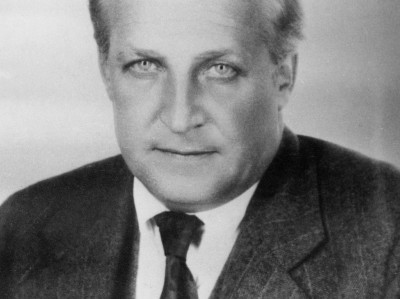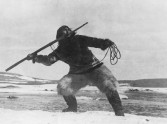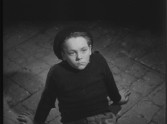
The Lost Worlds of Robert Flaherty
Short Films
-
Twenty-Four Dollar Island
Directed by Robert Flaherty.
US, 1927, 35mm, black & white, 15 min.
Print source: Bruce Posner
This stunningly beautiful and vibrant “city symphony” celebrates the Manhattan of 1927 from the machinery of the waterfront to the trees of Central Park.
While in Europe attempting to slink into the Soviet Union to make a film, Flaherty was approached by London’s Empire Marketing Board Film Unit to document craftsmanship within industrial Britain with his famously observant and respectful eye. EMB's head John Grierson—who actually coined the term “documentary” in his review of Moana—was forced to intervene when Flaherty quickly exceeded his government-allotted time and budget, feeling his way into the subject by filming “experiments.” Flaherty and Grierson's mutual exasperation aside, the finished film transcends its propagandistic purpose and unveils a reverent ode to the ancient traditions of skilled craft and labor. Graceful, expressive images of workers weaving cloth, harvesting grain and making baskets give way to glass-blowing and pottery-making, then pouring metal, engineering airplane motors and disappearing into dark coal mines. “Behind the smoke, beautiful things are being made,” states the narrator as human and machine function together in dignified harmony beneath Flaherty’s earnest light.
A lost film until the 2013 discovery of a 35mm nitrate print at Harvard University, Robert Flaherty’s 1935 short film Oidhche Sheanchais offers a disarming and fascinating distillation of his ardent belief in cinema as a mythopoeic art and folkloric tradition. To record the soundtrack of Man of Aran Flaherty brought the principal members of his cast to London, inviting Colman “Tiger” King, Maggie Dirrane, Patch “Red Beard” Ruadh and young Michaeleen to retrospectively add dialogue, in English and in pre-Jean Rouch fashion, to select scenes of the film. During their extended stay in London Flaherty reassembled the nuclear family invented for Man of Aran for a second film commissioned by the Department of Education, gathering his four “actors” around a sound studio hearth, together with famed seanchai (story-teller) Seáinín Tom Ó Dioráin. In striking contrast to Man of Aran, the resultant film, Oidhche Sheanchais, was recorded entirely in the dialect of the Aran Islands and is, in fact, considered the first talkie in the Irish language. Speaking and singing in their native tongue, Dirrane, Ruadh and especially O’Diorain deliver beautifully animated performances that bring a rare intimacy to Oidhche Sheanchais, making clear Flaherty’s unique relationship to his actors and giving new human dimension to these now legendary men, woman and child of Aran.
The surging, symphonic poetry of Man of Aran is powerfully emblematized in Flaherty’s bold imagery of the restless North Atlantic whose unyielding waves and currents unceasingly threaten the fishermen’s boats and very lives. All of Flaherty’s feature films are anchored in just such a mythologization of Man locked in an eternal struggle with Nature. Oidhche Sheanchais stands apart, then, as a purely interior film, set entirely within a sound stage and without any of the lyrical nature imagery so central to Flaherty’s visionary cinema. Yet, despite its explicit interiority and literal enclosure within an artificial studio set, Oidhche Sheanchais remains, like Flaherty’s other films, an adventurous exploration of a vast, unchartered land. For Oidhche Sheanchais is, above all, a film about the interior yet fathomless world of the imagination, a limitless realm from which emerges the song and story shared by the fireside group, each a fantasy echo of central themes of Man of Aran. In this way Ó Dioráin’s fiery telling of a well-known tale of Irish water spirits who tempt yet are ultimately tamed by an Aran fisherman, makes explicit the animistic and deeply Romantic vision of nature animating both Flaherty’s cinema and the folkloric world that so inspired him. And Maggie Dirrane’s moving rendition of the Irish ballad, recalls the longing, melancholy and even dark tragedy which defines lives dependent upon the sea.
As both a figure of a world out of time and a kind of a portal to the imagination, Oidhche Sheanchais’ minimal set also beautifully recalls the cottage hearth tended by Maggie Dirrane in Man of Aran; a miniaturized and seemingly self-sustaining world, a domestic island, with chickens and lambs warming themselves alongside the baby’s cradle while a kettle heats above the fire. An embodiment of the “infinite immensity” described by Gaston Bachelard, the hearth fire is also where young Michaeleen, in one Man of Aran’s loveliest moments, drifts to sleep, followed by a montage of images of the restless ocean that seem to spring from the boy’s dreams of joining his father’s oceanic adventure. As backdrop to O’Diorian’s spirited story-telling, the dancing shadow and flame of the hearth fire in Oidhche Sheanchais is also, of course, a figure for cinema itself, bringing a meta-cinematic dimension to Flaherty’s reanimation of ancient tradition. As Flaherty’s first work with direct sound, the film crackles with the miracle of the new technology and its ability to so vividly render the cadence and lilt of the Aran dialect spoken and sung by the actors. And yet the figure of Tiger King, the Man of Aran himself, seems still locked in another realm, standing fixed in a statuesque pose, not speaking a word, a figure then for the lost and receding world of the silent cinema.
Flaherty was commissioned by the Department of Agriculture to make a film about the importance of farming in modern America. The result combines Flaherty’s longstanding passion for tradition and community with his post-Grierson reconciliation with modernity. This wide-ranging film essay is even more episodic than Industrial Britain, with each segment resembling—in the words of Siegfried Kracauer—“fragments of a lost epic song that celebrated the immense life of the land; nothing is omitted and each episode is full of significance.”













